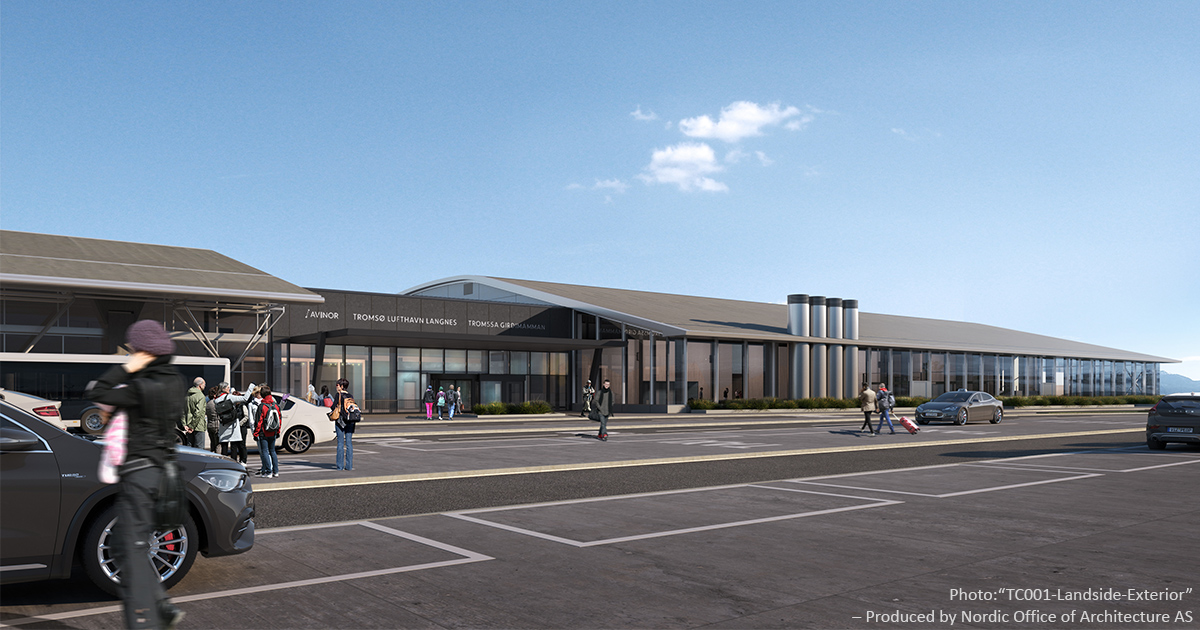We had the opportunity to talk to Andreas Myräng, BIM Coordinator of the Tromsø airport project, on behalf of Avinor. With his background as a structural engineer and writer of the project’s BIM strategy, he is the person to talk to learn more about the project and the ambitious BIM requirements.
The operator of most of the Norwegian civil airports is Avinor AS, which also makes them owner of the Tromsø airport project. The aim of the project is to expand the existing terminal building by roughly double the size. The estimated expansion is about 10 000 m2 and the development will lead to increased capacity and improved facilities. There are some substantial redesigns of the existing terminals as well as renovations of older parts of the building. With this comes some project necessities such as a temporary terminal and other practicalities to support the passenger activities.
The project’s process and requirements are governed by a set of documents, decided upon by Avinor. The role of the BIM Coordinator is to make sure the designers fulfil these requirements. These documents are often referred to as a BIM manual and is a sort of guide that controls the work process, governs communication, and describes delivery requirements.

– Most requirements have a technical nature, such as “does this object have the required information put into this set of parameters”. Others are more general, such as the quality of the visual model, explains Andreas.
To make this huge project a success, both consultants and local project management need to be part of the team. Andreas is a hired consultant and apart from making sure all requirements are up to code, he also manages the project and works as a bridge between the central BIM ambition of Avinor and the engineers working on the project.
– For project execution, there are two perspectives. There is the project level and operation and maintenance level. For operation and management, it’s all about future maintenance work, and this is where the BIM model comes in, says Andreas. – The BIM model comes with an object database containing a lot of information about each BIM object. This greatly helps with facility management and future expansions.
BIM has been all the rage for a while, but it is now really people are starting to see the actual benefits BIM adds to a construction project. Andreas feels that we are approaching a point where the industry can see the real value, especially now with the possibility to have digital drawings coupled with BIM or automated reporting resources.
– I think the main obstacle to overcome when working with BIM is to learn how to reap the benefits from the work done. Now that we’re drawing BIM, making models, and supplying it with a huge amount of information, how do we get the normal user and not only super users to extract the information they want from the model. This is the main obstacle, but we are reaching a new level of maturity here as well.
Fire safety is a great example of this. When fire safety equipment is installed into a building and is present in the BIM model, a lot of information is supplied to the BIM object. This information could be type of product, what systems it belongs to, and so forth and it is readily available in a database. The actual use of that information might come into play when a fire inspector does their round to check up on this equipment. This inspection might be years after installation, and it is in this moment the information is used.
The ambition with the project’s digital strategy is multifaceted. Largely, the quality of documentation during and after construction is in focus, but there are also economic and sustainable dimensions. One of the major drawbacks when looking into an existing building is often a lack of information.
– From experience, documentation for existing building is usually lacking. By creating, and then continuously developing the project BIM models, we help our further selves with facility management, adds Andreas.
From an economical perspective, BIM adds a lot of efficiency and quality to the work process. Communication is smoother and mistakes are more easily corrected, thanks to easier visual clash detections.
The Tromsø airport project is working with digital fire safety data to add another level of quality to the documents. Fire safety data is critical in construction project, and especially good to know for future maintenance.
– What if we’re looking to expand, and I want to know what kind of wall is separating each section? Then I need to know what the actual classification is for this wall, is it EI30 or EI60? This is very useful information for an object and the BIM requirement of Avinor reflects this. We have requirements for certain types of parameters. For example, is this a fire safety exit door or not? What are the fire requirements for this wall, or this window, or this door?
Concluding, it can be said that for checking various requirements for fire safety, there is a lot of potential. Fire safety is still working to catch up to other, more BIM-experienced disciplines and Andreas is looking forward to how development will proceed.
– We still must find best practice for how to check various requirements, how we create visuals of escape plans or deciding on the actual documentation formats. There are, I assume, a lot of different ways to solve this with BIM and this the industry have to look into. But there are a lot of possibilities and we’re excited to see what ’Rambøll & Nordic’ will show us!
’Rambøll & Nordic’ are responsible for all architectural and engineering services for the project, including fire safety design and follow-up during the construction phase. To implement fire safety BIM requirements Rambøll are active users of Bimfire Tools. This way, the project will be supplemented with fire data in its BIM objects.
The Bimfire Team thanks Andreas and Avinor for taking the time to chat with us, and we can’t wait to see the first flight to depart from the new terminal in 2023.
